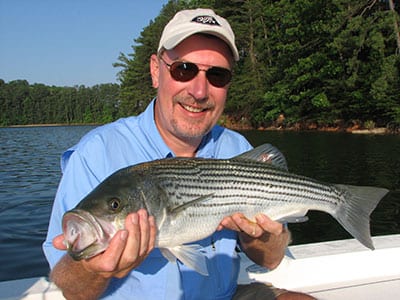
NutsAndBoltsFishing.com
Summertime is here! It’s hot for us humans, and it’s hot for the fish too. For us two-legged critters, we can seek the comfort and cooling of indoor air-conditioning. For fish, that’s not exactly practical, so they have to look for cooler water temperatures that deep water can provide.
First, let’s get down to the basics from a fish’s perspective. For the most part, fish have four priorities, and they all center around survival.
- Oxygen – Fish have to breathe, even though it’s through their gills. Cool water can hold a higher concentration of dissolved oxygen than hot water so fish will naturally go to depths that are cooler than the warmer surface temperatures.
- Food – Just like us, fish have to eat to survive. Their natural food sources are going to usually hang out where the water temps are comfortable to them. An active striped bass will eat almost half its body weight in food every day.
- Safety – In the world beneath the waves, it’s eat or be eaten. Top-of-the-food-chain predators like striped bass will consume just about anything that represents a tasty meal, including smaller stripers. Baitfish spend the majority of their lives hanging around cover, or schooling up because there’s safety in numbers.
- Make babies – Although the preceding three items have the highest priority, there are times when all that goes out the window in order to propagate the species. Just before the spawn and just after the spawn are the times when most game fish get really hungry because they know it could be a few weeks before their minds return to eating again.
In the hot summertime, you should shift your fishing gameplan to locating the top two items: oxygen and food. That can mean fishing deep, or it can mean fishing early or late. A cool night can cool down the surface water temperature and encourage the baitfish to move to shallower humps and creeks. Nighttime fishing around dock lights that attract baitfish is also a good bet. By the time the sun touches the treetops, most big fish are headed to deeper water where they can get plenty of oxygen.
Fish are cold-blooded critters, so as the water heats up, they will become a little more sluggish and not as eager to chase a fast-retrieved bait, so slow down your presentations a bit. Try using live bait or cut natural bait, and fish it on a downline or very slow retrieve. A big striper or bass that’s trying its best just to survive is less likely to expend a lot of energy to dart after a fast-trolled spoon.
In our deeper reservoirs, like Lanier, Hartwell and others, if you adjust your sonar sensitivity up higher, you should be able to see the thermocline. It will look like a thin line that’s kind of ‘fuzzy’, somewhere between 25 and 40 feet down. This is a layer of water that sets up in the summer months separating the warm water above from the cold water below. Above the thermocline, the water is warm and doesn’t hold as much dissolved oxygen. Below the thermocline, the water is much colder and there’s virtually no oxygen. The thermocline becomes the ‘sweet spot’ where most fish will find comfortable temperatures and more oxygen, and that’s the thought to keep in your mind regarding depths to fish.
The moral of this story: the fish haven’t left the pond. They’ve just relocated to places where they can survive. Keep this in mind on your next fishing trip, and you’ll probably put a few more fish in the boat.